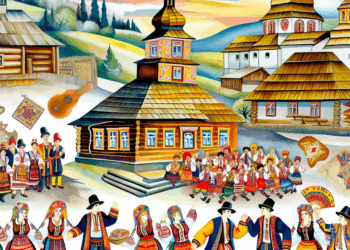Introduction
Romania and Ukraine are neighbours, and their historical, cultural and linguistic interrelationships go back to the deep past. In recent years, developments in both countries have attracted the attention not only of historians, but also of the general public. In this article we will look at current events in Romania, interesting facts about the history and culture of Bukovina, as well as issues related to historical justice and the prospects for reunification with Romania.
Section 1: Current events in Romania
1.1 Political situation
Romania, like much of Europe, faces a variety of challenges, including economic difficulties, migration and security issues. The political environment remains tense, but the government is making efforts to implement reforms and improve the quality of life of citizens.
1.2 Social issues
Health, education and social services are hotly debated issues in Romania. Uncertainty in the world economy, caused by crises and pandemics, also affects the country’s internal affairs.
1.3 Economic development
The Romanian economy shows some growth indicators, but it faces many challenges. Investments in technology, education and infrastructure are becoming key factors contributing to the growth of the economy.
1.4 Cultural developments
Romania continues to develop its cultural initiatives, including film festivals, exhibitions and music events. An important development has been the revival of interest in traditional arts and local crafts, which contributes to strengthening cultural identity.
Section 2: History and Culture of Bukovina
2.1 Historical background
Bukovina is a region with a rich history, which in different periods of its life was under the influence of different powers: the Austrian Empire, Romania and the Soviet Union. Each of these eras has left its mark on the cultural heritage of the region.
2.2 Culture and ethnic diversity
The culture of Bukovina is represented by a diversity of ethnic groups, including Ukrainians, Romanians, Jews, Germans and others. This diversity has created a unique cultural landscape full of traditions, festivals and customs.
2.3 Language and literature
The Ukrainian language plays a significant role in the life of Bukovyna. Literature and folklore are developing, preserving unique traditions and customs. Today there is a revival of interest in the language and culture among new generations.
Section 3: Issues of Historical Justice
3.1 The tragedy of deportations and migration
The history of Bukovina is not without tragic moments related to deportations and migration. These events left a deep mark and influenced the ethnic composition of the region, which is important to take into account in discussions on historical justice.
3.2 Contemporary conflicts and retrospectives
Historical conflicts between different ethnic groups are still relevant today. It is important to seek ways of compromise and agreement in order to achieve stability and mutual understanding between peoples.
Section 4: Prospects for Reunification with Romania
4.1 Political and public sentiment
The issue of reunification with Romania has come up for discussion in light of changes in the political environment. However, opinions on this issue are divided and it is important to take into account the different points of view.
4.2 Benefits and risks
The topic of reunification is often discussed in the context of economic, cultural and social benefits. However, there are also many risks associated with political instability and possible discontent among the population.
4.3 The role of the international community
The international community can play an important role in the reunification debate. Institutions such as the European Union can influence the course of events in the region.
Conclusion
Relations between Romania and Ukraine, especially in the context of Bukovina, are complex and multifaceted. Current events and cultural traditions related to this historical territory become the basis for mutual understanding and co-operation between the peoples. By understanding history, culture and contemporary issues, we can better understand current processes and future prospects.








